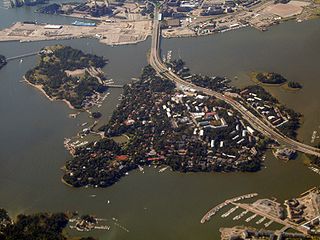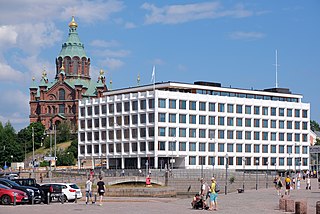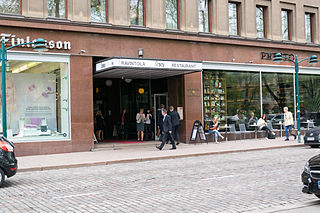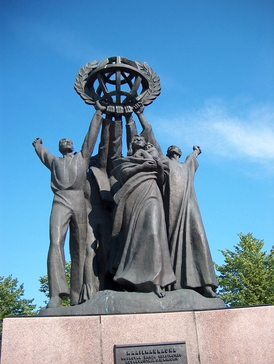Related Research Articles

Helsinki is the capital and most populous city in Finland. It is on the shore of the Gulf of Finland and is the seat of southern Finland's Uusimaa region. About 682,000 people live in the municipality, with 1.26 million in the capital region and 1.6 million in the metropolitan area. As the most populous urban area in Finland, it is the country's most significant centre for politics, education, finance, culture, and research. Helsinki is 80 kilometres (50 mi) north of Tallinn, Estonia, 400 kilometres (250 mi) east of Stockholm, Sweden, and 300 kilometres (190 mi) west of Saint Petersburg, Russia. Helsinki has significant historical connections with these three cities.

Helsinki University of Technology was a technical university in Finland. It was located in Otaniemi, Espoo in the Helsinki metropolitan area, and it was one of the three universities from which the modern day Aalto University was founded.. The university was founded in 1849 by Grand Duke of Finland, Emperor Nicholas I and received university status in 1908. It moved from Helsinki to Otaniemi campus area in 1966. The merger of HUT with two other schools created the Aalto University in 2010, and HUT briefly held the name Aalto University School of Science and Technology before being split into four schools in 2011.

Helsinki Cathedral is the Finnish Evangelical Lutheran cathedral of the Diocese of Helsinki, located in the neighborhood of Kruununhaka in the centre of Helsinki, Finland, at the Senate Square. The church was originally built from 1830 to 1852 as a tribute to the Grand Duke of Finland, Emperor Nicholas I of Russia. It was also known as St Nicholas's Church until Finland declared its full independence in 1917. It is a major landmark of the city, and one of the most famous historical structures in Finland as a whole when viewed globally.

The University of Helsinki metro station is a station on the Helsinki Metro. It serves the University of Helsinki and surrounding areas in the central Helsinki districts Kaisaniemi and Kluuvi. From 1995 to 2015, the station's name was Kaisaniemi. The station is 27 metres below ground level and 22 metres below sea level. It is positioned 600 metres east of the Central Railway Station and 900 metres south of Hakaniemi. Both lines M1 and M2 serve the station.

Neste Oyj is an oil refining and marketing company located in Espoo, Finland. It produces, refines and markets oil products, provides engineering services, and licenses production technologies. Neste has operations in 14 countries.

Uspenski Cathedral is a Greek Orthodox or Eastern Orthodox cathedral in Helsinki, Finland, and main cathedral of the Orthodox Church of Finland, dedicated to the Dormition of the Theotokos. Its name comes from the Old Church Slavonic word uspenie, which denotes the Dormition. It is the largest Greek Orthodox church in both Northern and Western Europe.

VTT Technical Research Centre of Finland Ltd is a state-owned and controlled non-profit limited liability company. VTT is the largest research and technology company and research centre conducting applied research in Finland. It provides research and innovation services and information for domestic and international customers and partners, both in private and public sectors.

Haloo Helsinki! is a pop rock band from Finland, founded in 2006. They have released five studio albums, all of which have reached the top ten on the Finnish Albums Chart. From 2007 to 2012, the band were signed to EMI Finland and as their principal collaborators switched to a Sony sub-label, Ratas Music Group, the band followed suit. In 2013, Haloo Helsinki! became the first Finnish artist whose four consecutive singles have peaked at number one on the Chart of commercial Finnish radio stations.

Aalto-1 was a Finnish research nanosatellite, created by students of Aalto University. Based on the CubeSat architecture, it was originally scheduled to be launched in 2013, it was launched on 23 June 2017. It was Finland's first student satellite project and indigenously produced satellite. As of 2021, the satellite was operational.

The Wihuri Sibelius Prize is a music prize awarded by the Wihuri Foundation for International Prizes to prominent composers who have become internationally known and acknowledged. The Wihuri Sibelius Prize is one of the biggest and most prestigious music prizes in the world of classical music. The first Sibelius Prize was awarded to Finnish composer Jean Sibelius, whom the prize was named after, in 1953. By 2021, the Wihuri Foundation for International Prizes has awarded altogether 19 Wihuri Sibelius Prizes, the latest award climbing up to €150,000 and awarded to Finnish composer Jukka Tiensuu. The Wihuri Sibelius Prize winner is selected by a five-member committee that consists of experts from Finnish music institutions. The prize may be awarded to private individuals or organizations regardless of nationality.
Pajtim Statovci is a Finnish novelist. His debut novel, Kissani Jugoslavia, was published in 2014, winning the Helsingin Sanomat Literature Prize for best debut novel in Finnish for that year, and was published in 2017 as My Cat Yugoslavia in the UK and US. It was made into a play and staged at the Finnish National Theatre in Helsinki in 2018. His second novel, Tiranan sydän, won the Toisinkoinen Literature Prize for 2016, and was published as Crossing in the UK and the US in 2019. Following the 2019 release of his third novel, Bolla, his publisher announced in February 2024 the upcoming September release of his fourth, Lehmä Synnyttää Yöllä.
Space Systems Finland (SSF) is a Finnish software and systems engineering company. Since its founding in 1989, the company has developed software and systems for several European Space Agency spacecraft.

Mustikkamaa is an island in the Gulf of Finland, some 5 kilometres (3.1 mi) to the east of the city centre of Helsinki, and c. 36 hectares in size.

Solar Foods is a producer of single cell protein founded in 2017. It focuses on using solar energy to produce food.

The Stora Enso headquarters is an office building located in the Katajanokka neighbourhood of central Helsinki, Finland, completed in 1962. It is notable for having been designed by the Finnish architect Alvar Aalto.

Åke Kalevi Keihänen was a Finnish travel agency entrepreneur, director of Keihäsmatkat and a groundbreaking figure in Finnish tourism. Keihänen became known for his extravagant behaviour, long hair and unique style of dress – in advertisement photography, he wore a chinchilla fur coat with only a pair of swimming trunks underneath. The coat was said to have cost him 120,000 markka. Keihänen was said to have copied his style of dress from the Danish travel agency entrepreneur Simon Spies.

Savoy is a restaurant in Helsinki, Finland, located on the Eteläesplanadi street. The restaurant opened on 3 June 1937. It is located in a space designed by Finnish architects Aino and Alvar Aalto, and furnished by the company Artek, which they had founded two years earlier. It was renovated in 2019. The Savoy is considered a hallmark of Finnish cuisine.

World peace is a bronze sculpture donated by the city of Moscow, Russia to the city of Helsinki, Finland, created by sculptor Oleg Kiryuhin. The sculpture was located at Hakaniemenranta in Helsinki, and it was revealed on 14 January 1990, two months after the Berlin Wall had been broken. The sculpture belongs to the collection of the Helsinki Art Museum. The sculpture was moved to storage on 8 August 2022, as part of the wave of monuments and memorials removal following the Russian invasion of Ukraine.

Kirsti Paakkanen was a Finnish entrepreneur and business executive.
Anni Katri Penttilä is a Finnish mountaineer from Helsinki, who in civilian life works as a digital marketing entrepreneur and a tour guide in Tanzania and Nepal.
References
- 1 2 "Reaktor: Most Innovative Company". Fast Company. Retrieved 2020-11-11.
- ↑ "Management lessons from an American general". The Economist. ISSN 0013-0613 . Retrieved 2020-11-11.
- ↑ "Razorfish, R/GA Vet Heads to Strategy, Design and Tech Firm Reaktor as President, North America". www.adweek.com. Retrieved 2020-11-11.
- ↑ Helsinki, Charlie Taylor in. "Helsinki firm pilots self-driving ferry". The Irish Times. Retrieved 2020-11-11.
- ↑ "Suomalaisyritys nappasi tv-jätti HBO:n – New Yorkissa olisi jo enemmän asiakkaita kuin voi ottaa". Yle Uutiset (in Finnish). Retrieved 2020-11-11.
- ↑ "Reaktor and adidas head for "all things future"". Good News from Finland. 2017-12-07. Retrieved 2020-11-11.
- ↑ "Teknologia | Maailman suurimpiin syövän sädehoitojen kehittäjiin kuuluva yhtiö turvautui suomalaisosaamiseen – Meilahdessa kehitetään hoidon tarkkuutta parantavaa ohjelmistoa". Helsingin Sanomat (in Finnish). 2020-07-05. Retrieved 2020-11-11.
- ↑ "Finland's airports will soon be run by AI". TechHQ. 2019-10-28. Retrieved 2020-11-11.
- ↑ "The direct approach - Issue 114 - Magazine". Monocle. Retrieved 2020-11-11.
- ↑ "NEW Webby Gallery + Index". NEW Webby Gallery + Index. Retrieved 2020-11-11.
- ↑ "The world's first festival to plant a forest - Winner - Integrated Campaigns and Advertising - German Design Award". www.german-design-award.com. Retrieved 2020-11-11.
- ↑ "Red Dot Design Award: Finnair – Onboard Service Platform". www.red-dot.org. Retrieved 2020-11-11.
- ↑ "Finland's grand AI experiment". POLITICO. 2019-01-02. Retrieved 2020-11-11.
- 1 2 Virki, Tarmo (2020-01-03). "Finland seeks to teach 1% of all Europeans basics on AI". Reuters. Retrieved 2020-11-11.
- ↑ "DAILY BRIEF: World-changing ideas, acquisitions, health and high technology, science and research". Good News from Finland. 2020-04-29. Retrieved 2022-08-03.
- ↑ Kurutz, Steven (2019-10-05). "New Yorkers Will Have to Wait for an East River Pool (Published 2019)". The New York Times. ISSN 0362-4331 . Retrieved 2020-11-11.
- ↑ "+ Pool's Floating Light Installation Changes Color Based on East River's Water Quality". HYPEBEAST. Retrieved 2020-11-11.
- ↑ "Building a cloud in space – this IT company is taking the space industry into the 21st century". International Business Times UK. 2016-12-07. Retrieved 2020-11-11.
- ↑ "Groundbreaking nanosatellite imaging technology brings new possibilities to manage climate change | VTT". www.vttresearch.com. Retrieved 2020-11-11.
- ↑ "Avaruus | Eurooppa ei saa jäädä start-up-yritysten jälkeen avaruuskilpailussa – Kolme asiantuntijaa listasi, missä Eurooppa voi vielä kehittyä". Helsingin Sanomat (in Finnish). 2020-03-15. Retrieved 2020-11-11.
- ↑ "Reaktor Space Lab and VTT investigate a new frequency band for telecommunications satellites | VTT". www.vttresearch.com. Retrieved 2020-11-11.
- ↑ "REAKTOR HELLO WORLD". N2YO.com. 22 October 2023. Retrieved 22 October 2023.
- ↑ Varghese, Sanjana (2019-10-23). "In Finland, prisoners are being taught crucial AI skills". Wired UK. ISSN 1357-0978 . Retrieved 2020-11-11.
- ↑ "A country's ambitious plan to teach anyone the basics of AI". MIT Technology Review. Retrieved 2020-11-11.
- ↑ "Koulu | Helsingin yliopiston kaikkien aikojen suosituin kurssi saa jatkoa – järjestäjien tavoitteena opettaa tekoälyn perusteet prosentille maailman väestöstä". Helsingin Sanomat (in Finnish). 2020-10-21. Retrieved 2020-11-11.
- ↑ "Reaktor Education". MIT Inclusive Innovation Challenge. Retrieved 2021-03-19.
- ↑ "Hello World! Poland Wins First Computer Coding Championship". NBC News. Retrieved 2020-11-11.